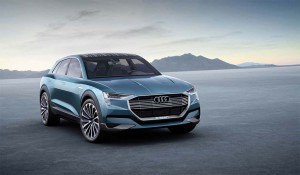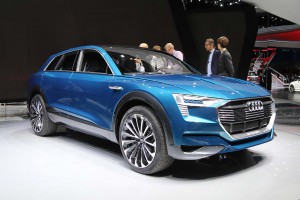For now, it’s just a show car, drawing curious gawkers to the maker’s stand at the L.A. Auto Show, but in less than three years, Audi intends to have a production version of the e-tron Quattro Concept in showrooms around the world.
And with a range of more than 300 miles, the German maker is betting the electric SUV will charge up consumers, becoming a mainstream rather than niche product. The added range is just one of the positive factors, however. Audi is expecting a sharp decrease in the cost of batteries by the time the production SUV comes to market in 2018.
And, with a slew of additional e-tron models, both plug-in hybrids and pure battery-electric vehicles, or BEVs, in the works, Audi planners predict the technology could soon account for as much as a quarter of their U.S. sales.
“We’re committed to this,” said Siegfried Pint, Audi AG’s director electric powertrains. “As we go further, each and every day, we see there’s a reality to this.
Most major automakers have begun working up electrification strategies. General Motors, for example, just launched a second-generation Chevrolet Volt plug-in and is developing the 200-mile Chevy Bolt battery-electric model. Mercedes-Benz plans to have 10 plug-ins by 2018. Volvo plans to offer battery options for all models, but its goal of reaching 10% of its sales with electrified products in 2020 falls well short of where Audi sees itself going.

The Audi e-tron Quattro concept is just the beginning of the brand's plans to expand its EV offerings across its portfolio.
Only Toyota has outlined a more ambitious plan, but it is largely focusing on conventional hybrids and hydrogen-electric vehicles, rather than those using large battery packs.
Audi’s strategy has generated some skepticism, critics questioning whether its ambitious goal might be intended to offset the negative publicity surrounding its ongoing diesel emissions scandal. But Filip Brabec, director of product planning for Audi of America, said during an interview at the L.A. Auto Show, the maker couldn’t work that fast. And, in fact, the e-tron Quattro Concept was first shown two months earlier at the Frankfurt Motor Show.
(VW, Audi officials apologize, try to look beyond diesel scandal at L.A. Auto Show. For more, Click Here.)
Virtually every automaker now offers at least one vehicle using a lithium-ion battery pack. But many of those products have been derided as “compliance vehicles,” designed to meet the minimum demands of regulators in California who have set out a tough zero-emissions vehicle, or ZEV, mandate. Sergio Marchionne, the CEO of Fiat Chrysler, went as far as urging potential customers not to buy the electrified Fiat 500 because the carmaker would “lose money on every one.”
Brabec stressed that Audi is not planning to build compliance cars. Its focus is “with the intention of (them) being mainstream products.”
And the maker sees several critical steps to make the transition from niche vehicles with limited appeal:
- Longer range is essential, and as batteries becoming smaller, lighter and more energy-dense, that will become easier to achieve, said Pint;
- Battery costs must also come down. The battery powertrain manager said Audi is targeting a cost of less than 145 Euros, or $154 at current exchange rates, per kilowatt-hour, about one-seventh what lithium technology cost at the end of the last decade;
- Audi also is taking steps to make it easier — and quicker – to charge up, The maker aims to set up a network of fast-charge stations that would allow the production e-tron SUV add another 200 miles in less than 30 minutes.
There, it’s not the only one pushing for a broader charging infrastructure. Tesla Motors is setting up its own nationwide network of so-called Superchargers, 440-volt DC Level III charging stations.
(Click Here for details about new consortium helping EV owners ROEV more easily.)
Separately, a new consortium of automakers, suppliers and public charging station owners, dubbed ROEV, was announced during the L.A. Auto Show this week. Its participants represent 91% of all public chargers currently in use in the U.S., about 17,500 in total. This will allow someone subscribing to the services of one participant to charge up at a facility operated by any ROEV member.
Increased performance is another factor that should boost demand for plug-based vehicles, said Pint. Electric motors make gobs of torque and can offer incredible off-the-line acceleration, as Tesla is demonstrating with its new “Ludicrous” mode for the Model S. They also can be used for torque vectoring, shifting power from axle to axle and wheel to wheel to improve cornering and handling.
Audi, meanwhile, intends to shift away from designing electrified vehicles that emphasize what some have called the “geek” factor, quirky styling meant to make them stand out in a crowd.
(To see more about Audi’s full-stop order on diesel sales, Click Here.)
“The time when we preached that because it’s electric it has to look different, that’s going to go away,” stressed Brabec. The goal is to come up with “a cool car that people want to drive.”

